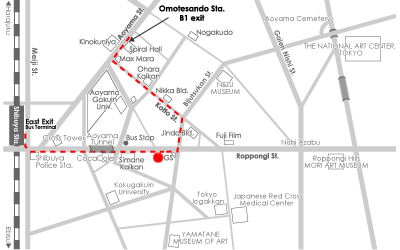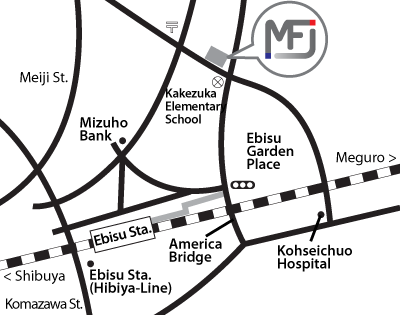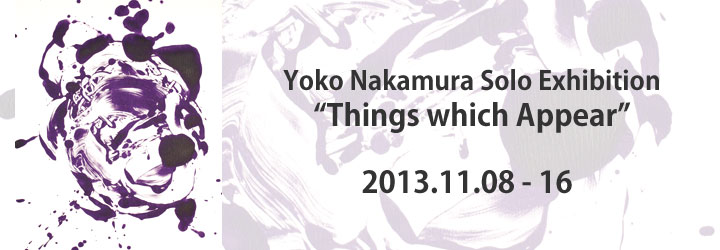|
|
|
|
 |
 |
The Paintings Which Rise From the Vestige of an Act |
 |
If you look close to the screen, you will be overwhelmed by the crowds of vestige which was made with speedy action. Otherwise, if you look over the whole of vestiges, all the dynamism is made to be forgotten and you will be wrapped in secretly. Yoko Nakamura's works are known as the duet of the occasional change of nature and the silence which freezes on the change. This impression, that is likely to cut all the changing sound, reminds us of the "General Pause" of the Romatic music which uses even the silence as nourishment. The "General Pause" of the symphony which uses all sounds as nourishment and the silence on the paintings, which is the final goal of repeated expression are not essentially identified in the same category. However, Nakamura's work which was sublimated by the organic combination of the dynamic details and the luxurious silence "General Pause" which impresses next creation seem to be overlapped within me.
The dynamic motion and speed which are the pronouns of Nakamura's paintings are produced with not a paintbrush but her palm, or her fingers, which is called "Finger Painting". The "Finger Painting" that removes the restriction of a paintbrush was brought by the trend of modern-paintings which aims at the direct expression related to the gesture or the act. Simultaneously, if we see the fact that ancient human beings had left the cave wall painting by the same drawing technique, relation of the "Finger Painting" and the desire to return to the origin will not be able to be disregarded, either. Although I have forgotten to ask her why she uses fingers and a palm instead of a brush, it must be correct that her choise to use them was based on that she was aware of something which can not be satisfied by a paintbrush. Nevertheless, these exhibited works show that only the primitive dynamism which was directly linked with a gesture or an act is not the final goal which the artist has searched for. Because, we will see not only paintings which were drawn with fingers and a palm but the two types of paintings which were derived from the "Finger Painting". One of them are the works which were rubbed, extended and transmitted by Valen from the "Finger Painting". Another one is covered the "Finger Painting" with gypsum, dug it partially and made to appear the screen of lower layer. The focus of the former is on the form which is appeared in the front instead of the eliminated substance. On the other hand, the latter focuses on the color which is exposed partially from the lower layer of white gypsum. The paintings of Nakamura which was started from expression with fingers or a palm are moving forward to research of a form and color which are the fundamental element to form painting. Yoko Nakamura pours the breath of a thrilling expression into every screen, then she expects patiently to establish the image which she desires. Haruo Sanda / Art Journalist |
 |
 |
|
|
 |
|
Public Collections Boseong-gun Baekmin Art Museum(South Korea)
The Nave of Setagayasan Kannonji Temple(Tokyo)
STAR HILL(Chinese Restaurant) in Kyoto Tokyu Hotel(Kyoto)
Reception Lobby of Xiv Yamanaka Lake(Yamanashi)
Information Hall of Palace Grandeur Yamagata(Yamagata)
Restaurant Toki of Xiv Hakone Rikyu(Kangawa)
Book Covers
|
|
 |
Yoko Nakamura |
 |
[ SOLO EXHIBITION ] |
1994-2017 |
Sweden House Gallery(Tokyo), Gallery Center Point(Tokyo), Kaneko Art Gallery(Tokyo), Kuso Galleria(Tokyo), A.J.M.Gallery(N.Y.), Gallery Uniglavas Ginza(Tokyo), Residence of Mr.Mase(Karuizawa), Gallery Yume(Tokyo), Gallery Yamaguchi(Tokyo), Mominoki Gallery(Tokyo), Shonandai My Gallery(Tokyo), Gallery AMANO(Yamanashi), DOKA Contemporary Arts(Tokyo), LA MAISON FRANCO-JAPONAISE Entrance Hall(Tokyo), MIKISSIMES GINZA GALLERY(Tokyo), Steps Gallery(Tokyo) |
[ GROUP EXHIBITION ] |
1990-1997 |
Kanagawa International Print Independants Exhibition(Kanagawa Kenmin Hall Gallery) |
1991-1996 |
Exhibition of Joryu Gaka Kyokai(Tokyo Metropolitan Art Museum) |
1999-2000 |
International exhibition of ContemporaryArt (Gwangju National Museum in South Korea, Kanagawa Kenmin Hall Gallery in Japan) |
1999-2011 |
Print Miyagi(Sendai Mediatheque) |
2000 |
The Moments of Art 2000(Muse the square in Saitama)
Group show(A.J.M.Gallery in New York) |
2001 |
Frontier21(Kanagawa public Gallery in Yokohama)
Today's Art Formation 2001(Busan - Tokyo)
Korea-Japan Women's Art (Inzei Art Museum in Korea) |
2002 |
LINEART (Flanders Expo) /Belgium
KOREA-JAPAN Interchange Festival (Korea Embassy Gallery in Tokyo)
The International Women's Contemporary Art (Meguro Museum in Tokyo)
|
2005 |
The 21th South Region Contemporary Festival (Gwangju Biennale Hall in Korea)
Today's NO-War Exhibition (Maruki Museum in Saitama)
|
2006 |
MIART (in Milan, Italy)
BIEAF 2006 (Busan International Environment Art Festival in Korea)
|
2007 |
The 50 Anniversary Art Exhibition of the diplomatic relation Japan &Ireland (The Ireland Ambassador to Japan official residence in Tokyo) |
2011 |
ACKid 2011(art/music/dance/performance exhibition in Tokyo) |
2015 |
ODISHA BIENNALE 2015 (NIFT in Bhobaneshwar, India) |
2016 |
The 13th International Biennial of Miniature Art (Gornji Milano Vac in Serbia) |
2017 |
[Adventures on Surface]-Apocalypse of Abstraction- (Ko Gallery in Tokyo) |
|
|
 |
 |
Yoko Nakamura Solo Exhibition
"Things which Appear" |
 Subway : Ginza-Line,Hanzomon-Line,Chiyoda-Line
10 minutes on foot from B1 exit of Omotesando Sta. |
Yoko Nakamura |
 |
November 8(Fri) - 16(Sat), 2013 |
1:00pm - 7:00pm
Closed on Sunday |
 |
DOKA Contemporary Arts |
7-1-12, Minami Aoyama, Minato-ku, Tokyo. 107-0062
TEL : 03-3407-3477 |
 |
|
 Train : JR Yamanote-Line
10 minutes on foot from east exit of Ebisu Sta.
Subway : Hibiya-Line
12 minutes on foot from 1 exit of Ebisu Sta. |
Yoko Nakamura |
 |
November 11(Mon) - 22(Fri), 2013 |
10:00am - 6:00pm
Closed on Sunday |
 |
|
3-9-25, Ebisu, Shibuya-ku, Tokyo. 150-0013
TEL : 03-5424-1141 |
 |
|
 |
Copyright © DOKA Contemporary Arts All Rights Reserved. |
|
|
|
| | |










